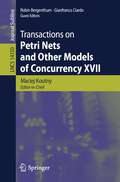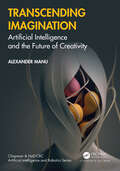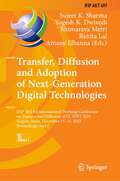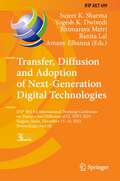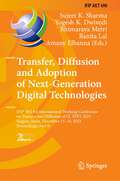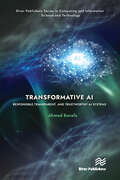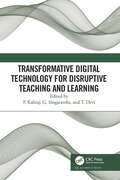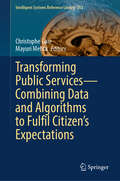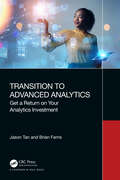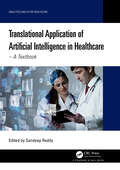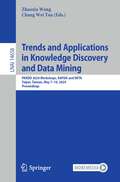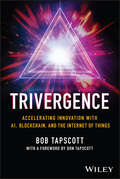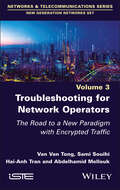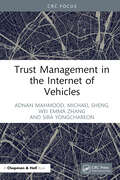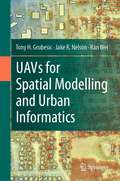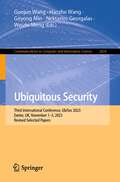- Table View
- List View
Transactions on Petri Nets and Other Models of Concurrency XVII (Lecture Notes in Computer Science #14150)
by Maciej Koutny Robin Bergenthum Gianfranco CiardoTransactions on Petri Nets and Other Models of Concurrency (ToPNoC) XVII. These Transactions publish archival papers in the broad area of Petri nets and other models of concurrency, ranging from theoretical work to tool support and industrial applications. ToPNoC issues are published as LNCS volumes, and hence are widely distributed and indexed. This Journal has its own Editorial Board which selects papers based on a rigorous two-stage refereeing process. ToPNoC contains: – Revised versions of a selection of the best papers from workshops and tutorials at the annual Petri net conferences – Special sections/issues within particular subareas (similar to those published in the Advances in Petri Nets series) – Other papers invited for publication in ToPNoC – Papers submitted directly to ToPNoC by their authors The 17th volume of ToPNoC contains revised and extended versions of a selection of the best workshop and tutorial papers presented at the 43rd International Conference on Application and Theory of Petri Nets and Concurrency, Petri Nets 2022. The papers cover a diverse range of topics including model checking and system verification, refinement and synthesis, foundational work on specific classes of Petri nets, and innovative applications of Petri nets and other models of concurrency. Application areas covered in this volume are: process mining, verification, formal semantics, distributed simulations, business processes, distributed systems, and net synthesis. Thus, this volume gives a good overview of ongoing research on concurrent systems and Petri nets.
Transcending Imagination: Artificial Intelligence and the Future of Creativity (Chapman & Hall/CRC Artificial Intelligence and Robotics Series)
by Alexander ManuImagine a world where the boundaries of creativity are not only stretched but redefined. This book serves as your guide to this new frontier, engaging general readers, tech enthusiasts, and creatives alike in the captivating interplay between human ingenuity and artificial intelligence (AI).Journey through the ground-breaking advancements in AI as they intersect with art, design, entertainment, and education. Discover how AI’s power to analyze and understand language can be harnessed to generate breathtaking visuals from mere text descriptions—a process known as text-conditional image generation. But this book goes beyond just showcasing AI’s capabilities: it delves into its transformative effects on the creative process itself. How will artists and designers adapt to a world where they co-create with machines? What are the implications of AI-generated art in educational settings? This book tackles these questions head on, offering a comprehensive view of the changing landscape of creativity.At its core, this book challenges you to rethink what’s possible in the realm of artistic expression. Manu contends that as AI evolves, mastering the art of collaboration between human and machine will become essential. More than just a look into the future, Transcending Imagination: Artificial Intelligence and the Future of Creativity is a roadmap for artists, designers, and educators eager to navigate the uncharted territory of AI-augmented creativity. It is a must-read for anyone interested in how AI might redefine the realms of art, design, and education.
Transcending Imagination: Artificial Intelligence and the Future of Creativity (Chapman & Hall/CRC Artificial Intelligence and Robotics Series)
by Alexander ManuImagine a world where the boundaries of creativity are not only stretched but redefined. This book serves as your guide to this new frontier, engaging general readers, tech enthusiasts, and creatives alike in the captivating interplay between human ingenuity and artificial intelligence (AI).Journey through the ground-breaking advancements in AI as they intersect with art, design, entertainment, and education. Discover how AI’s power to analyze and understand language can be harnessed to generate breathtaking visuals from mere text descriptions—a process known as text-conditional image generation. But this book goes beyond just showcasing AI’s capabilities: it delves into its transformative effects on the creative process itself. How will artists and designers adapt to a world where they co-create with machines? What are the implications of AI-generated art in educational settings? This book tackles these questions head on, offering a comprehensive view of the changing landscape of creativity.At its core, this book challenges you to rethink what’s possible in the realm of artistic expression. Manu contends that as AI evolves, mastering the art of collaboration between human and machine will become essential. More than just a look into the future, Transcending Imagination: Artificial Intelligence and the Future of Creativity is a roadmap for artists, designers, and educators eager to navigate the uncharted territory of AI-augmented creativity. It is a must-read for anyone interested in how AI might redefine the realms of art, design, and education.
Transfer, Diffusion and Adoption of Next-Generation Digital Technologies: IFIP WG 8.6 International Working Conference on Transfer and Diffusion of IT, TDIT 2023, Nagpur, India, December 15–16, 2023, Proceedings, Part I (IFIP Advances in Information and Communication Technology #697)
by Sujeet K. Sharma Yogesh K. Dwivedi Bhimaraya Metri Banita Lal Amany ElbannaThis book constitutes the refereed proceedings of the IFIP WG 8.6 International Working Conference on Transfer and Diffusion of IT, TDIT 2023, which took place in Nagpur, India, in December 2023. The 87 full papers and 23 short papers presented in these proceedings were carefully reviewed and selected from 209 submissions. The papers are organized in the following topical sections:Volume I:Digital technologies (artificial intelligence) adoption; digital platforms and applications; digital technologies in e-governance; metaverse and marketing.Volume II:Emerging technologies adoption; general IT adoption; healthcare IT adoption.Volume III:Industry 4.0; transfer, diffusion and adoption of next-generation digital technologies; diffusion and adoption of information technology.
Transfer, Diffusion and Adoption of Next-Generation Digital Technologies: IFIP WG 8.6 International Working Conference on Transfer and Diffusion of IT, TDIT 2023, Nagpur, India, December 15–16, 2023, Proceedings, Part III (IFIP Advances in Information and Communication Technology #699)
by Sujeet K. Sharma Yogesh K. Dwivedi Bhimaraya Metri Banita Lal Amany ElbannaThis book constitutes the refereed proceedings of the IFIP WG 8.6 International Working Conference on Transfer and Diffusion of IT, TDIT 2023, which took place in Nagpur, India, in December 2023. The 87 full papers and 23 short papers presented in these proceedings were carefully reviewed and selected from 209 submissions. The papers are organized in the following topical sections: Volume I: Digital technologies (artificial intelligence) adoption; digital platforms and applications; digital technologies in e-governance; metaverse and marketing. Volume II: Emerging technologies adoption; general IT adoption; healthcare IT adoption. Volume III: Industry 4.0; transfer, diffusion and adoption of next-generation digital technologies; diffusion and adoption of information technology.
Transfer, Diffusion and Adoption of Next-Generation Digital Technologies: IFIP WG 8.6 International Working Conference on Transfer and Diffusion of IT, TDIT 2023, Nagpur, India, December 15–16, 2023, Proceedings, Part II (IFIP Advances in Information and Communication Technology #698)
by Sujeet K. Sharma Yogesh K. Dwivedi Bhimaraya Metri Banita Lal Amany ElbannaThis book constitutes the refereed proceedings of the IFIP WG 8.6 International Working Conference on Transfer and Diffusion of IT, TDIT 2023, which took place in Nagpur, India, in December 2023. The 87 full papers and 23 short papers presented in these proceedings were carefully reviewed and selected from 209 submissions. The papers are organized in the following topical sections: Volume I: Digital technologies (artificial intelligence) adoption; digital platforms and applications; digital technologies in e-governance; metaverse and marketing. Volume II: Emerging technologies adoption; general IT adoption; healthcare IT adoption. Volume III: Industry 4.0; transfer, diffusion and adoption of next-generation digital technologies; diffusion and adoption of information technology.
Transformative AI: Responsible, Transparent, and Trustworthy AI systems (River Publishers Series in Computing and Information Science and Technology)
by Ahmed BanafaTransformative Artificial Intelligence provides a comprehensive overview of the latest trends, challenges, applications, and opportunities in the field of Artificial Intelligence. The book covers the state of the art in AI research, including machine learning, natural language processing, computer vision, and robotics, and explores how these technologies are transforming various industries and domains, such as healthcare, finance, education, and entertainment.The book also addresses the challenges that come with the widespread adoption of AI, including ethical concerns, bias, and the impact on jobs and society. It provides insights into how to mitigate these challenges and how to design AI systems that are responsible, transparent, and trustworthy.The book offers a forward-looking perspective on the future of AI, exploring the emerging trends and applications that are likely to shape the next decade of AI innovation. It also provides practical guidance for businesses and individuals on how to leverage the power of AI to create new products, services, and opportunities.Overall, the book is an essential read for anyone who wants to stay ahead of the curve in the rapidly evolving field of Artificial Intelligence and understand the impact that this transformative technology will have on our lives in the coming years.
Transformative AI: Responsible, Transparent, and Trustworthy AI systems (River Publishers Series in Computing and Information Science and Technology)
by Ahmed BanafaTransformative Artificial Intelligence provides a comprehensive overview of the latest trends, challenges, applications, and opportunities in the field of Artificial Intelligence. The book covers the state of the art in AI research, including machine learning, natural language processing, computer vision, and robotics, and explores how these technologies are transforming various industries and domains, such as healthcare, finance, education, and entertainment.The book also addresses the challenges that come with the widespread adoption of AI, including ethical concerns, bias, and the impact on jobs and society. It provides insights into how to mitigate these challenges and how to design AI systems that are responsible, transparent, and trustworthy.The book offers a forward-looking perspective on the future of AI, exploring the emerging trends and applications that are likely to shape the next decade of AI innovation. It also provides practical guidance for businesses and individuals on how to leverage the power of AI to create new products, services, and opportunities.Overall, the book is an essential read for anyone who wants to stay ahead of the curve in the rapidly evolving field of Artificial Intelligence and understand the impact that this transformative technology will have on our lives in the coming years.
Transformative Digital Technology for Disruptive Teaching and Learning
Generation Z students are avid gamers and are always on social media. Smart like their phones, they must be educated in a smart manner, which involves the use of digital tools. Transformative Digital Technology for Disruptive Teaching and Learning provides smart education solutions and details ways in which Gen Z learners can be educated. It covers such digital learning strategies as blended learning, flipped learning, mobile learning, and gamification. It examines creative teaching–learning strategies to encourage modern learners to learn more quickly. The book discusses ways to accelerate the capabilities of teaching and learning transactions. It also covers innovative teaching and learning processes to meet the challenges of digital learners.Starting with an overview of digital learning resources and processes as well as their advantages and disadvantages, the book then discusses such approaches and strategies as follows: Learner-oriented and learner-friendly approaches Blended learning Active learning Experiential learning Virtual learning Applications of Cloud Computing and Artificial Intelligence Gamification LMS challenges and techno-pedagogical issues for modern life As digital technology is disrupting teaching and learning, especially the skill development of students in the era of Industry 4.0 and 5.0, this is a timely book. It provides methods, approaches, strategies, and techniques for innovative learning and teaching. It discusses how to leverage new technology to enhance educators’ and learners’ abilities and performance. A comprehensive reference guide for educational researchers and technology developers, the book also helps educators embrace the digital transformation of teaching and learning.
Transformative Digital Technology for Disruptive Teaching and Learning
by P. Kaliraj G. Singaravelu T. DeviGeneration Z students are avid gamers and are always on social media. Smart like their phones, they must be educated in a smart manner, which involves the use of digital tools. Transformative Digital Technology for Disruptive Teaching and Learning provides smart education solutions and details ways in which Gen Z learners can be educated. It covers such digital learning strategies as blended learning, flipped learning, mobile learning, and gamification. It examines creative teaching–learning strategies to encourage modern learners to learn more quickly. The book discusses ways to accelerate the capabilities of teaching and learning transactions. It also covers innovative teaching and learning processes to meet the challenges of digital learners.Starting with an overview of digital learning resources and processes as well as their advantages and disadvantages, the book then discusses such approaches and strategies as follows: Learner-oriented and learner-friendly approaches Blended learning Active learning Experiential learning Virtual learning Applications of Cloud Computing and Artificial Intelligence Gamification LMS challenges and techno-pedagogical issues for modern life As digital technology is disrupting teaching and learning, especially the skill development of students in the era of Industry 4.0 and 5.0, this is a timely book. It provides methods, approaches, strategies, and techniques for innovative learning and teaching. It discusses how to leverage new technology to enhance educators’ and learners’ abilities and performance. A comprehensive reference guide for educational researchers and technology developers, the book also helps educators embrace the digital transformation of teaching and learning.
Transformers for Natural Language Processing and Computer Vision: Explore Generative AI and Large Language Models with Hugging Face, ChatGPT, GPT-4V, and DALL-E 3
by Denis RothmanUnleash the full potential of transformers with this comprehensive guide covering architecture, capabilities, risks, and practical implementations on OpenAI, Google Vertex AI, and Hugging Face Purchase of the print or Kindle book includes a free eBook in PDF formatKey FeaturesMaster NLP and vision transformers, from the architecture to fine-tuning and implementationLearn how to apply Retrieval Augmented Generation (RAG) with LLMs using customized texts and embeddingsMitigate LLM risks, such as hallucinations, using moderation models and knowledge basesBook DescriptionTransformers for Natural Language Processing and Computer Vision, Third Edition, explores Large Language Model (LLM) architectures, applications, and various platforms (Hugging Face, OpenAI, and Google Vertex AI) used for Natural Language Processing (NLP) and Computer Vision (CV). The book guides you through different transformer architectures to the latest Foundation Models and Generative AI. You’ll pretrain and fine-tune LLMs and work through different use cases, from summarization to implementing question-answering systems with embedding-based search techniques. You will also learn the risks of LLMs, from hallucinations and memorization to privacy, and how to mitigate such risks using moderation models with rule and knowledge bases. You’ll implement Retrieval Augmented Generation (RAG) with LLMs to improve the accuracy of your models and gain greater control over LLM outputs. Dive into generative vision transformers and multimodal model architectures and build applications, such as image and video-to-text classifiers. Go further by combining different models and platforms and learning about AI agent replication. This book provides you with an understanding of transformer architectures, pretraining, fine-tuning, LLM use cases, and best practices.What you will learnLearn how to pretrain and fine-tune LLMsLearn how to work with multiple platforms, such as Hugging Face, OpenAI, and Google Vertex AILearn about different tokenizers and the best practices for preprocessing language dataImplement Retrieval Augmented Generation and rules bases to mitigate hallucinationsVisualize transformer model activity for deeper insights using BertViz, LIME, and SHAPCreate and implement cross-platform chained models, such as HuggingGPTGo in-depth into vision transformers with CLIP, DALL-E 2, DALL-E 3, and GPT-4VWho this book is forThis book is ideal for NLP and CV engineers, software developers, data scientists, machine learning engineers, and technical leaders looking to advance their LLMs and generative AI skills or explore the latest trends in the field. Knowledge of Python and machine learning concepts is required to fully understand the use cases and code examples. However, with examples using LLM user interfaces, prompt engineering, and no-code model building, this book is great for anyone curious about the AI revolution.
Transforming Public Services—Combining Data and Algorithms to Fulfil Citizen’s Expectations (Intelligent Systems Reference Library #252)
by Christophe Gaie Mayuri MehtaThis book provides a precise portrayal of the current trends and future perspectives of e-Government. It outlines new approaches that optimize public services across diverse sectors. Going beyond traditional boundaries, it offers mathematical models for public services supported by convincing case studies. This book significantly enhances various government services, such as education, healthcare, safety, security, and culture. It also strongly emphasizes safeguarding citizens' personal data, ensuring privacy, and obtaining explicit consent. Tailored for students and academics, the book is an invaluable reference for teaching graduate courses in e-Government, Process Modelling, or Artificial Intelligence. Its impact extends beyond the classroom; civil servants from all domains can find practical insights to navigate the ongoing modernization of public services. Even citizens curious about the transformation in their public services can find this book enlightening. Researchers working in the area of e-Governance can use this book to discover the recent developments in e-Government.
Transition to Advanced Analytics: Get a Return on Your Analytics Investment
by Jason Tan Brian FerrisAmazon knows the products we’re interested in and shows us more to boost the size of our shopping cart. Google Maps knows the best route to get from A to B and recommends it to get us there in the shortest possible time. Netflix knows the media we enjoy most and recommends more to boost streaming time. However, many companies still fall short with their data analytics practices.This book focuses on how to embed advanced analytics directly into daily business operations and complement an enterprise system. This book can guide you in how traditional industries like retailers, banks and insurers can utilise and develop advanced analytics complementing their enterprise systems while embedding advanced analytics directly to optimise revenue and customer experience. Detailed in this book is a world-class analytics application used by loyalty point providers, banks, insurers and leading retailers.The title also provides a step-by-step implementation framework for Chief Digital and Artificial Intelligence Offices to develop their advanced analytics capabilities in tandem with legacy IT systems.
Transition to Advanced Analytics: Get a Return on Your Analytics Investment
by Jason Tan Brian FerrisAmazon knows the products we’re interested in and shows us more to boost the size of our shopping cart. Google Maps knows the best route to get from A to B and recommends it to get us there in the shortest possible time. Netflix knows the media we enjoy most and recommends more to boost streaming time. However, many companies still fall short with their data analytics practices.This book focuses on how to embed advanced analytics directly into daily business operations and complement an enterprise system. This book can guide you in how traditional industries like retailers, banks and insurers can utilise and develop advanced analytics complementing their enterprise systems while embedding advanced analytics directly to optimise revenue and customer experience. Detailed in this book is a world-class analytics application used by loyalty point providers, banks, insurers and leading retailers.The title also provides a step-by-step implementation framework for Chief Digital and Artificial Intelligence Offices to develop their advanced analytics capabilities in tandem with legacy IT systems.
Translational Application of Artificial Intelligence in Healthcare: - A Textbook (Analytics and AI for Healthcare)
by Sandeep ReddyIn the era of 'Algorithmic Medicine', the integration of Artificial Intelligence (AI) in healthcare holds immense potential to address critical challenges faced by the industry. Drawing upon the expertise and experience of the authors in medicine, data science, medical informatics, administration, and entrepreneurship, this textbook goes beyond theoretical discussions to outline practical steps for transitioning AI from the experimental phase to real-time clinical integration. Using the Translational Science methodology, each chapter of the book concisely and clearly addresses the key issues associated with AI implementation in healthcare. Covering technical, clinical, ethical, regulatory, and legal considerations, the authors present evidence-based solutions and frameworks to overcome these challenges. Engaging case studies and a literature review of peer-reviewed studies and official documents from reputed organizations provide a balanced perspective, bridging the gap between AI research and actual clinical practice.
Translational Application of Artificial Intelligence in Healthcare: - A Textbook (Analytics and AI for Healthcare)
In the era of 'Algorithmic Medicine', the integration of Artificial Intelligence (AI) in healthcare holds immense potential to address critical challenges faced by the industry. Drawing upon the expertise and experience of the authors in medicine, data science, medical informatics, administration, and entrepreneurship, this textbook goes beyond theoretical discussions to outline practical steps for transitioning AI from the experimental phase to real-time clinical integration. Using the Translational Science methodology, each chapter of the book concisely and clearly addresses the key issues associated with AI implementation in healthcare. Covering technical, clinical, ethical, regulatory, and legal considerations, the authors present evidence-based solutions and frameworks to overcome these challenges. Engaging case studies and a literature review of peer-reviewed studies and official documents from reputed organizations provide a balanced perspective, bridging the gap between AI research and actual clinical practice.
Trends and Applications in Knowledge Discovery and Data Mining: PAKDD 2024 Workshops, RAFDA and IWTA, Taipei, Taiwan, May 7–10, 2024, Proceedings (Lecture Notes in Computer Science #14658)
by Zhaoxia Wang Chang Wei TanThis book constitutes the workshops that have been held in conjunction with the 27th Pacific-Asia Conference on Knowledge Discovery and Data Mining, PAKDD 2023, which took place in Osaka, Japan, during May 25–28, 2023. For RAFDA 2024, Workshop on Research and Applications of Foundation Models for Data Mining and Affective Computing, 15 submissions have been received and 9 full papers have been accepted for publication. For IWTA 2024, International Workshop on Temporal Analytics, 4 full papers have been accepted from a total of 6 submissions.
TRIVERGENCE: Accelerating Innovation with AI, Blockchain, and the Internet of Things
by Bob TapscottA Breakthrough Introduction to The Next Phase of the Digital Age In Trivergence, Bob Tapscott, writer, speaker, complex system designer, and former CIO introduces an exciting new concept in explaining how the intersection of artificial intelligence (AI), blockchain, and the Internet of Things (IoT) will transform business and society. He explains the synergies between these technologies and the disruptive potential that they will offer, as well as the challenges and risks to making it happen. He offers an insightful guide through the difficult decisions that businesses and society must make to thrive in a new era where decisions will be difficult, and uncertainties abound. You'll discover how and why AI's power is now exploding, its growth driven by smarter approaches to neural networks trained on a new hardware architecture that can derive its intelligence from ever more massive datasets. You'll also find: Discussions of the multiplicative and exponential power of trivergence on the core technologies discussed in the book Explorations of IoT's tendency to bring the physical world to life as it harnesses the capabilities of AI and the blockchain How trivergence morphs Big Data into something new he calls “Infinite Data”, where thinking machines consider trillions of data points to generate their own content, value, and perspectives without programmed code or human intervention A fresh and innovative guide, rich with case stories, on how the most critical technologies of this new phase in the digital age are combining to drive business transformation, Trivergence will become a critical handbook for forward-looking leaders, and anyone interested in the intersection of cutting-edge tech and business.
TRIVERGENCE: Accelerating Innovation with AI, Blockchain, and the Internet of Things
by Bob TapscottA Breakthrough Introduction to The Next Phase of the Digital Age In Trivergence, Bob Tapscott, writer, speaker, complex system designer, and former CIO introduces an exciting new concept in explaining how the intersection of artificial intelligence (AI), blockchain, and the Internet of Things (IoT) will transform business and society. He explains the synergies between these technologies and the disruptive potential that they will offer, as well as the challenges and risks to making it happen. He offers an insightful guide through the difficult decisions that businesses and society must make to thrive in a new era where decisions will be difficult, and uncertainties abound. You'll discover how and why AI's power is now exploding, its growth driven by smarter approaches to neural networks trained on a new hardware architecture that can derive its intelligence from ever more massive datasets. You'll also find: Discussions of the multiplicative and exponential power of trivergence on the core technologies discussed in the book Explorations of IoT's tendency to bring the physical world to life as it harnesses the capabilities of AI and the blockchain How trivergence morphs Big Data into something new he calls “Infinite Data”, where thinking machines consider trillions of data points to generate their own content, value, and perspectives without programmed code or human intervention A fresh and innovative guide, rich with case stories, on how the most critical technologies of this new phase in the digital age are combining to drive business transformation, Trivergence will become a critical handbook for forward-looking leaders, and anyone interested in the intersection of cutting-edge tech and business.
Troubleshooting for Network Operators: The Road to a New Paradigm with Encrypted Traffic
by Van Van Tong Sami Souihi Hai-Anh Tran Abdelhamid MelloukNowadays, the Internet is becoming more and more complex due to an everincreasing number of network devices, various multimedia services and a prevalence of encrypted traffic. Therefore, in this context, this book presents a novel efficient multi modular troubleshooting architecture to overcome limitations related to encrypted traffic and high time complexity. This architecture contains five main modules: data collection, anomaly detection, temporary remediation, root cause analysis and definitive remediation. In data collection, there are two sub modules: parameter measurement and traffic classification. This architecture is implemented and validated in a software-defined networking (SDN) environment.
Troubleshooting for Network Operators: The Road to a New Paradigm with Encrypted Traffic
by Van Van Tong Sami Souihi Hai-Anh Tran Abdelhamid MelloukNowadays, the Internet is becoming more and more complex due to an everincreasing number of network devices, various multimedia services and a prevalence of encrypted traffic. Therefore, in this context, this book presents a novel efficient multi modular troubleshooting architecture to overcome limitations related to encrypted traffic and high time complexity. This architecture contains five main modules: data collection, anomaly detection, temporary remediation, root cause analysis and definitive remediation. In data collection, there are two sub modules: parameter measurement and traffic classification. This architecture is implemented and validated in a software-defined networking (SDN) environment.
Trust Management in the Internet of Vehicles
by Adnan Mahmood Michael Sheng Wei Emma Zhang Sira YongchareonThe Internet of Vehicles (IoV) is referred to as an efficient and inevitable convergence of the Internet of Things, intelligent transportation systems, edge / fog and cloud computing, and big data, all of which could be intelligently harvested for the cooperative vehicular safety and non-safety applications as well as cooperative mobility management. A secure and low-latency communication is, therefore, indispensable to meet the stringent performance requirements of the safety-critical vehicular applications. Whilst the challenges surrounding low latency are being addressed by the researchers in both academia and industry, it is the security of an IoV network which is of paramount importance, as a single malicious message is perfectly capable enough of jeopardizing the entire networking infrastructure and can prove fatal for the vehicular passengers and the vulnerable pedestrians. This book thus investigates the promising notion of trust in a bid to strengthen the resilience of the IoV networks. It not only introduces trust categorically in the context of an IoV network, i.e., in terms of its fundamentals and salient characteristics, but further envisages state-of-the-art trust models and intelligent trust threshold mechanisms for segregating both malicious and non-malicious vehicles. Furthermore, open research challenges and recommendations for addressing the same are discussed in the same too.
Trust Management in the Internet of Vehicles
by Adnan Mahmood Michael Sheng Wei Emma Zhang Sira YongchareonThe Internet of Vehicles (IoV) is referred to as an efficient and inevitable convergence of the Internet of Things, intelligent transportation systems, edge / fog and cloud computing, and big data, all of which could be intelligently harvested for the cooperative vehicular safety and non-safety applications as well as cooperative mobility management. A secure and low-latency communication is, therefore, indispensable to meet the stringent performance requirements of the safety-critical vehicular applications. Whilst the challenges surrounding low latency are being addressed by the researchers in both academia and industry, it is the security of an IoV network which is of paramount importance, as a single malicious message is perfectly capable enough of jeopardizing the entire networking infrastructure and can prove fatal for the vehicular passengers and the vulnerable pedestrians. This book thus investigates the promising notion of trust in a bid to strengthen the resilience of the IoV networks. It not only introduces trust categorically in the context of an IoV network, i.e., in terms of its fundamentals and salient characteristics, but further envisages state-of-the-art trust models and intelligent trust threshold mechanisms for segregating both malicious and non-malicious vehicles. Furthermore, open research challenges and recommendations for addressing the same are discussed in the same too.
UAVs for Spatial Modelling and Urban Informatics
by Tony H. Grubesic Jake R. Nelson Ran WeiThis book aims to provide a wide range of real-world applications in using unmanned aerial vehicles (UAVs) for geographic observation, spatial modeling, and urban informatics. Specifically, UAVs are incredibly effective platforms for connecting people, places, and technology. This book explores the utility of UAVs for monitoring, measuring, and improving urban infrastructure systems, urban sustainability, and the urban environment. The dynamism of cities provides opportunities for economic, social, and environmental change, but benchmarking and measuring cities continues to be challenging. This challenge is due, at least in part, to a lack of monitoring systems that can collect and analyze data at a granular enough scale to capture the nuance of local phenomena. UAVs offer a promising mechanism to fill this niche, serving as a measurement platform that can rapidly and inexpensively collect data and monitor change in cities. However, their use is fraught with social, operational, regulatory, and technical challenges for successful deployments. This book provides a resource for urbanists (e.g., planners, geographers, sociologists, epidemiologists, engineers), educators, and students who work with geographic information and seek to enhance these data using data and information from unmanned aerial vehicles. At the same time, we provide operational and methodological frameworks for carrying out these advanced analyses in a manner that considers the challenges of incorporating UAVs in research within the urban environment. We provide six unique applications of UAVs for urban analysis, detailing relevant policy and empirical questions, UAV mission parameters, data collection, spatial modeling, and the associated empirical results. Further, we discuss how best to integrate these results into actionable geospatial intelligence and policy development to improve city infrastructure systems, sustainability, the environment, and neighborhood quality.
Ubiquitous Security: Third International Conference, UbiSec 2023, Exeter, UK, November 1–3, 2023, Revised Selected Papers (Communications in Computer and Information Science #2034)
by Guojun Wang Haozhe Wang Geyong Min Nektarios Georgalas Weizhi MengThis book constitutes the proceedings of the Third International Conference, UbiSec 2023, held in Exeter, UK, during November 1–3, 2023.The 29 full papers were carefully reviewed and selected from 91 submissions. They were organized in following topical sections: Cyberspace Security, Cyberspace Privacy, Cyberspace Anonymity
